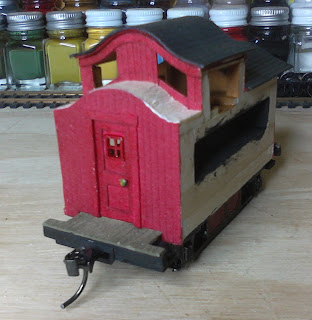I bought a can of Durham's "Rock Hard" Water Putty because I need something to cast my street with, but also because I like the design of the can (reminds me of the "Pep Boys.") I have used plaster of paris in the past, but wanted to try something different. So I am currently experimenting with Durham's, and initial tests are quite promising.
The greatest asset of Durham's is its natural color. It dries to a perfect California desert yellow. The info on the can says that it won't take a stain after it dries, but that's not an issue for me. The desert color is exactly what I want for a base color. The setting time seems about average, firming up in an hour or so, and drying out completely by the next day. The hardness is good also, being soft enough to carve, yet very durable. I'm quite excited about the possibilities!
 |
| Flexible enough to crack without breaking. |
My first test was to mix up a stiff batch and spread it into a form made of 1/8" balsa strips pinned to a plywood slab. I smoothed it out as best I could, but the surface was still a little irregular (this turned out to be a plus, as it dries resembling a flat rock surface.) After it set up, I took away the forms and popped it off the plywood. Overnight it acquired a slight curve, since one side dried faster than the other. I pressed it flat, and it cracked from a corner to the center without breaking in half. Another good sign, and the crack looks quite natural. I scribed a few grooves in the face, and carved out a few bricks. As far as I'm concerned, the effect is absolutely amazing.
 |
| Wet carved bricks are at the top, dry carved below. |
I carved a few bricks while it was still damp, and several more when it was dry. The difference is slight, but noticeable. The softer you carve, the rounder your brick corners will be. Personally, I think the best thing is to carve while dry. You have better control. I'm using a bookbinder's bodkin, which has a sharp but substantial point. Scribe the courses with a ruler, then cut the courses into individual bricks by hand. Then scribe around each brick to round off the corners and break up the regularity.
So for the initial test, I'm absolutely thrilled. I have now poured an identical slab of much wetter mixture, and a thicker slab of wetter still. Stay tuned for further experiments.







